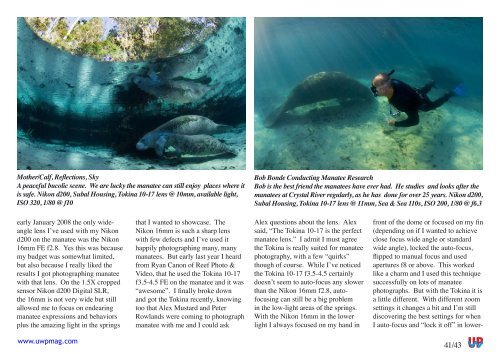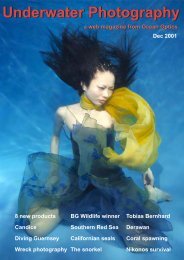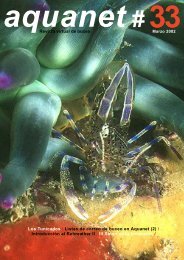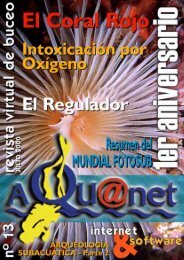Underwater Photography Underwater Photography
Underwater Photography Underwater Photography
Underwater Photography Underwater Photography
Create successful ePaper yourself
Turn your PDF publications into a flip-book with our unique Google optimized e-Paper software.
Mother/Calf, Reflections, Sky<br />
A peaceful bucolic scene. We are lucky the manatee can still enjoy places where it<br />
is safe. Nikon d200, Subal Housing, Tokina 10-17 lens @ 10mm, available light,<br />
ISO 320, 1/80 @ f10<br />
Bob Bonde Conducting Manatee Research<br />
Bob is the best friend the manatees have ever had. He studies and looks after the<br />
manatees at Crystal River regularly, as he has done for over 25 years. Nikon d200,<br />
Subal Housing, Tokina 10-17 lens @ 11mm, Sea & Sea 110s, ISO 200, 1/80 @ f6.3<br />
early January 2008 the only wideangle<br />
lens I’ve used with my Nikon<br />
d200 on the manatee was the Nikon<br />
16mm FE f2.8. Yes this was because<br />
my budget was somewhat limited,<br />
but also because I really liked the<br />
results I got photographing manatee<br />
with that lens. On the 1.5X cropped<br />
sensor Nikon d200 Digital SLR,<br />
the 16mm is not very wide but still<br />
allowed me to focus on endearing<br />
manatee expressions and behaviors<br />
plus the amazing light in the springs<br />
that I wanted to showcase. The<br />
Nikon 16mm is such a sharp lens<br />
with few defects and I’ve used it<br />
happily photographing many, many<br />
manatees. But early last year I heard<br />
from Ryan Canon of Reef Photo &<br />
Video, that he used the Tokina 10-17<br />
f3.5-4.5 FE on the manatee and it was<br />
“awesome”. I finally broke down<br />
and got the Tokina recently, knowing<br />
too that Alex Mustard and Peter<br />
Rowlands were coming to photograph<br />
manatee with me and I could ask<br />
Alex questions about the lens. Alex<br />
said, “The Tokina 10-17 is the perfect<br />
manatee lens.” I admit I must agree<br />
the Tokina is really suited for manatee<br />
photography, with a few “quirks”<br />
though of course. While I’ve noticed<br />
the Tokina 10-17 f3.5-4.5 certainly<br />
doesn’t seem to auto-focus any slower<br />
than the Nikon 16mm f2.8, autofocusing<br />
can still be a big problem<br />
in the low-light areas of the springs.<br />
With the Nikon 16mm in the lower<br />
light I always focused on my hand in<br />
front of the dome or focused on my fin<br />
(depending on if I wanted to achieve<br />
close focus wide angle or standard<br />
wide angle), locked the auto-focus,<br />
flipped to manual focus and used<br />
apertures f8 or above. This worked<br />
like a charm and I used this technique<br />
successfully on lots of manatee<br />
photographs. But with the Tokina it is<br />
a little different. With different zoom<br />
settings it changes a bit and I’m still<br />
discovering the best settings for when<br />
I auto-focus and “lock it off” in lower-<br />
www.uwpmag.com<br />
41/43
















